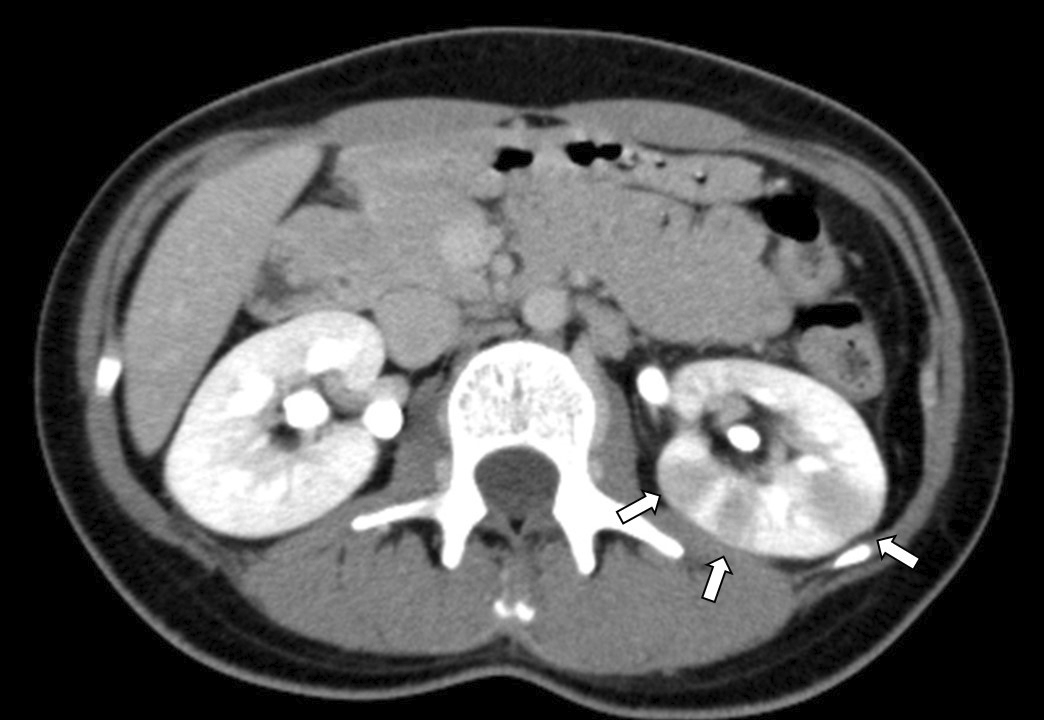Corresponding author: Junki Mizumoto, jnk_mizu@yahoo.co.jp
DOI: 10.31662/jmaj.2024-0091
Received: May 7, 2024
Accepted: June 20, 2024
Advance Publication: August 9, 2024
Published: October 15, 2024
Cite this article as:
Mizumoto J. Fetal Position Manifestation in Acute Focal Bacterial Nephritis. JMA J. 2024;7(4):633-634.
Key words: acute focal bacterial nephritis, fetal position, urinary tract infection
A 25-year-old woman presented with left flank pain and fever for 5 days. Two days before the presentation, the patient visited another hospital because of a fever and was prescribed amoxicillin plus clavulanic acid (2,000 and 500 mg/d), with no culture test performed. Despite the antibiotic treatment, the symptoms worsened, prompting the patient’s visit to our hospital.
The patient sat in a wheelchair with the hip joint flexed outward, knee joint flexed, and back bent forward. Physical examination revealed tapping pain on the left costovertebral area and a positive psoas sign. A contrast computed tomography scan confirmed multiple areas of decreased enhancement in the left kidney (Figure 1), which was consistent with acute focal bacterial nephritis (AFBN). The patient had no predisposing factors. Blood and urine cultures were negative. Administering cefmetazole 3 g/d rapidly improved the resolution of fever and flank pain.

Flank pain is a common symptom in AFBN (1); however, it cannot independently establish a diagnosis (2). The patient assumed a fetal position, characterized by leaning forward and curling up in the knee-to-chest posture, which is also observed in patients with acute pancreatitis, aiming to reduce the stretch on the pancreas (3), as well as in patients with psoas abscess, intending to alleviate strain on the psoas muscle (4). Herein, the patient presumably adopted the fetal position to potentially mitigate additional tension on the Gerota fascia.
Visual inspection―a physical examination―is often omitted (5). The present report conveys a strong message: a hawk-eyed physician can notice the patient’s characteristic posture early in the patient encounter and provide a prompt diagnosis. Fetal position suggests retroperitoneal inflammation, including AFBN with tensive Gerota fascia, and be crucial to prevent progression to renal abscess (6).
None
Concept: J.M.; Design: J.M.; Data Collection and Processing: J.M.; Analysis and Interpretation: J.M.; Literature Search: J.M.; Writing: J.M.
Junki Mizumoto: 0000-0002-0783-7351
Informed consent was obtained from the patient.
Sieger N, Kyriazis I, Schaudinn A, et al. Acute focal bacterial nephritis is associated with invasive diagnostic procedures - a cohort of 138 cases extracted through a systematic review. BMC Infect Dis. 2017;17(1):240.
Bent S, Nallamothu BK, Simel DL, et al. Does this woman have an acute uncomplicated urinary tract infection? JAMA. 2002;287(20):2701-10.
Cappell MS. Acute pancreatitis: etiology, clinical presentation, diagnosis, and therapy. Med Clin North Am. 2008;92(4):889-923.
Mallick IH, Thoufeeq MH, Rajendran TP. Iliopsoas abscesses. Postgrad Med J. 2004;80(946):459-62.
Jiao S, Yan Z, Zhang C, et al. Clinical features of acute focal bacterial nephritis in adults. Sci Rep. 2022;12(1):7292.
Haring CM, Cools BM, van der Meer JW, et al. Student performance of the general physical examination in internal medicine: an observational study. BMC Med Educ. 2014;14:73.